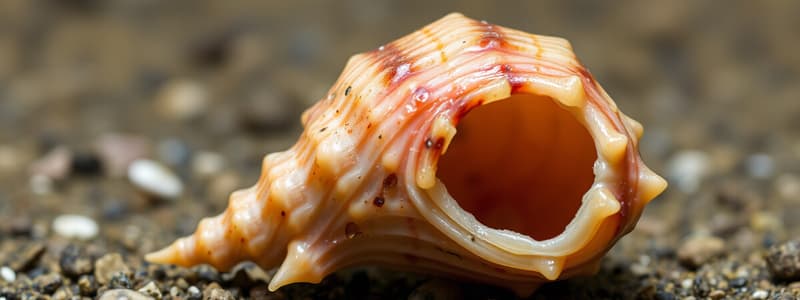Podcast
Questions and Answers
Which level of ecology refers to a specific species?
Which level of ecology refers to a specific species?
- Ecosystem
- Organism (correct)
- Community
- Population
A population consists of individuals from different species.
A population consists of individuals from different species.
False (B)
What is the main characteristic of organisms belonging to the phylum Mollusca?
What is the main characteristic of organisms belonging to the phylum Mollusca?
Soft-bodied with internal or external shells
The four parts of a mollusk's body plan are the foot, mantle, shell, and _______.
The four parts of a mollusk's body plan are the foot, mantle, shell, and _______.
Match the following phylum with their example species:
Match the following phylum with their example species:
What type of circulatory system do mollusks have?
What type of circulatory system do mollusks have?
According to Malthus' theory, what is the relationship between population growth and food production?
According to Malthus' theory, what is the relationship between population growth and food production?
The respiration system of mollusks primarily uses lungs.
The respiration system of mollusks primarily uses lungs.
Preventive checks include factors like war and disease.
Preventive checks include factors like war and disease.
What is the primarily feeding structure in mollusks called?
What is the primarily feeding structure in mollusks called?
What are the two main types of checks that can regulate population size according to Malthus?
What are the two main types of checks that can regulate population size according to Malthus?
According to Malthus, population always increases when the means of subsistence increase unless prevented by some powerful ______.
According to Malthus, population always increases when the means of subsistence increase unless prevented by some powerful ______.
Match the following terms with their definitions:
Match the following terms with their definitions:
What is a vestigial structure in humans?
What is a vestigial structure in humans?
Ecology only studies biotic factors within an environment.
Ecology only studies biotic factors within an environment.
What determines the size of a population according to the Malthusian principle?
What determines the size of a population according to the Malthusian principle?
Which of the following is NOT a characteristic of living organisms?
Which of the following is NOT a characteristic of living organisms?
Homeostasis refers to the ability of an organism to reproduce.
Homeostasis refers to the ability of an organism to reproduce.
What term describes the ability of an organism to adjust to changes in environmental conditions?
What term describes the ability of an organism to adjust to changes in environmental conditions?
______ are living organisms that shape their environment.
______ are living organisms that shape their environment.
Match the following characteristics of living organisms with their definitions:
Match the following characteristics of living organisms with their definitions:
Which of the following is an abiotic factor in an ecosystem?
Which of the following is an abiotic factor in an ecosystem?
Reproduction is essential for the survival of individual organisms.
Reproduction is essential for the survival of individual organisms.
Name a biotic factor found in a terrestrial ecosystem.
Name a biotic factor found in a terrestrial ecosystem.
Flashcards are hidden until you start studying
Study Notes
Malthusian Principle
- Population size is limited by food availability; more food leads to a larger sustainable population.
- Population growth follows geometric progression (multiples), while food production increases in arithmetic progression (addition).
- Population tends to increase when means of subsistence increase, unless powerful checks intervene.
- Population control mechanisms are categorized as:
- Positive checks (e.g., starvation, war, disease)
- Preventive checks (e.g., abstaining from sex, promoting late marriage, using contraceptives)
Biological Terms
- Fossils: Preserved remains/impressions of ancient organisms, including bones, shells, and exoskeletons.
- Homologous structures: Similar in structure but different in function.
- Analogous structures: Different anatomical structures serving similar functions.
- Vestigial structures: Non-functional remnants, like the human appendix and wisdom teeth.
Ecology
- Ecology: Study of interactions among organisms and their environments.
- Levels of Ecology:
- Organism: Specific species
- Population: Group of the same species
- Community: Populations in an area
- Ecosystem: Community with abiotic factors
- Biome: Ecosystem with similar climate (e.g., tundra, desert)
- Biosphere: Global sum of all ecosystems
Taxonomy and Phyla
- Phyla Examples: Mollusca, Porifera, Cnidaria, Platyhelminthes, Nematoda
- Phylum Mollusca:
- Consists of soft-bodied animals, often with shells (internal or external).
- Examples: Clams, squid, octopus, mussels, sea slugs.
- Development includes a free-swimming larval stage called trochophore.
Phylum Mollusca Features
-
Body Plan: Four parts
- Foot: Used for movement (crawling, burrowing)
- Mantle: Tissue covering organs
- Shell: Secreted by mantle, made of calcium carbonate
- Visceral mass: Contains internal organs
-
Feeding:
- Uses radula (a ribbon of teeth).
- Some filter feeders use incurrent and excurrent siphons.
-
Respiration and Circulation:
- Respiration through gills.
- Open circulatory system with heart and open sinuses.
-
Response and Movement:
- Clams have a simple nervous system; octopuses exhibit complex behaviors with brains.
- Movement facilitated by mucus, muscles, or jet propulsion.
Characteristics of Living Organisms
- Cellular organization: Composed of cells, tissues, organs, systems, and organisms.
- Homeostasis: Maintenance of a stable internal environment.
- Adaptation: Ability to adjust to environmental changes.
- Reproduction: Essential for sustaining life.
- Growth and development: Increase in size through cell division.
- Energy requirements: Continuous energy needed for life processes.
- Responsiveness: Ability to react to environmental stimuli.
Biotic and Abiotic Factors
- Biotic factors: Living organisms shaping environments (e.g., plants, fish).
- Abiotic factors: Non-living environmental elements (e.g., temperature, light, water, soil).
Studying That Suits You
Use AI to generate personalized quizzes and flashcards to suit your learning preferences.




